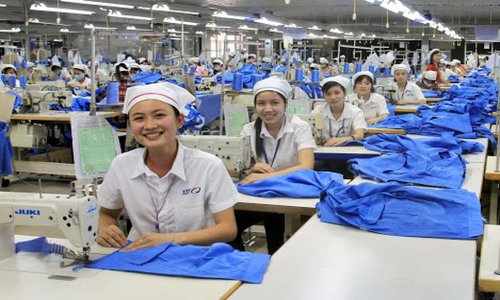Vietnam’s textile & garment industry: changed vision for development
These are impressive achievement amidst the unstable surroundings created by the global’s tendency toward protectionism and anti-globalization movement. According to the Chairman of Vietnam Textile & Apparel Association (VITAS) Vu Duc Giang, textile’s export value has been on high level recenty, which is expected to continue growing with many large textile – garment projects going into operation.
In the import side, materials imported to Vietnam in 2017 reached US$ 18.9 billion, for input matetials serving the purpose of producing exporting goods, its import value for textile production in Vietnam reached US$ 15.48 billion, resulting trade surplus of the garment industry to US$ 15.5 billion.
VITAS stressed the success of Vietnam’s textile & garment industry in recent years stem from the transformation of domestic enterprises through diversifying export markets, especially at leading enterprises which set pace for the whole industry. New markets for Vietnam’s textile & apparel products have been identified such as Japan, Korea, Russia, Africa and Middle East.
Taking advantages from signed free trade agreements (FTA) between Vietnam and other countries are the direction for the textile & garment industry going forward – said Giang. For example, the Vietnam – Eurasia Economic Union FTA (VN-EAEU FTA, including Russia, Armenia, Belarus, Kazakhstan and Kyrgyzstan) has changed the view of Vietnamese enterprises to this region. In which, companies such as Nha Be Garment or Duc Giang Corporation are playing pioneer role in the effort to infiltrate the Russian market.
Similarly, for the Japanese market, two main FTA with Japan such as ASEAN – Japan Comprehensive Economic Partnership (AJCEP) and Vietnam – Japan Economic Partnership Agreement (VJEPA) will be the foundation for the garment & textile industry to continue its development.
In the coming time, the Vietnam – EU FTA coming into force in the middle of 2018 will be expected to create breakthrough for many industrial sectors, including textile & garment. While in long term, the industry will be under positive impact from negotiating FTA such as Regional Comprehensive Economic Partnership (RCEP) between the ten member states of ASEAN and the six states with which ASEAN has existing FTA (Australia, China, India, Japan, South Korea and New Zealand), and especially the Comprehensive and Progressive Trans Pacific Partnership (CPTPP).


 Thailand
Thailand




